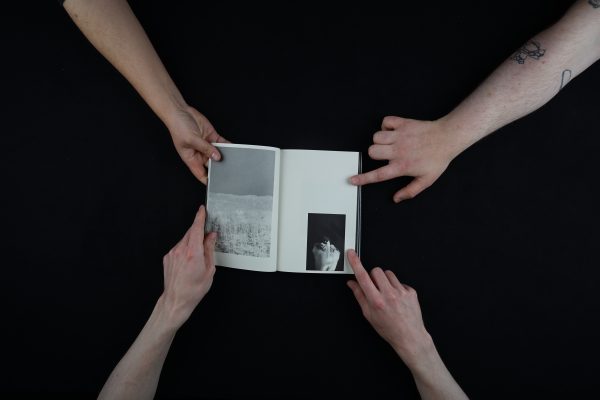4 a.m.
4 a.m.
A beautifully conceived photography publication, ‘4 A.M.’ is a visualand tactile experience rather than a typical example of Dutch book design.
The elements are organised intuitively rather than systematically. At first, the overall idea of print on coloured paper could seem overused; however, what makes the work break the preconceptions of an overplayed printing technique are the few perfectly executed choices in the production as a whole.
The book acts as a beautiful display of paper and print. The soft, delicate pages are so appealing to flip through, they engage the viewer into a slow devouring of the uncanny visuals. This eeriness is a well played out characteristic throughout the whole publication. Even with the use of colour, either of the paper itself or of the print, most of the imagery sinks in shadows and darkness.
The scenes depicted are hard to distinguish. Their mysticism is to be read and experienced by the viewer.There are clearly distinguished segments that switch between light and darker colour paper, almost as if going through different stages of the night.
The Japanese binding further emphasises the tactility of the piece, turning the book into a soft, cosy object. The folded pages bring extra airiness, while making it almost impossible for the viewer to flip through the content quickly – every page of this dreamy publication is experienced at a slow, intimate pace.
- Kunstenaar
- Paul Cupido
- Oplage
- 500
- Omvang
- 198
- Prijs
- € 80
- Verschijningsdatum
- september 2021
- Uitgever / Opdrachtgever
- self-published
- Ontwerper(s)
- Akiko Wakabayashi (Tilburg)
- Fotograaf
- Paul Cupido
- Drukkerij
- robstolk
- Lithograaf
- Alex Veenstra / robstolk
- Boekbinderij
- Agia
- Lettertype
- Larish Neue
A beautifully conceived photography publication, ‘4 A.M.’ is a visualand tactile experience rather than a typical example of Dutch book design.
The elements are organised intuitively rather than systematically. At first, the overall idea of print on coloured paper could seem overused; however, what makes the work break the preconceptions of an overplayed printing technique are the few perfectly executed choices in the production as a whole.
The book acts as a beautiful display of paper and print. The soft, delicate pages are so appealing to flip through, they engage the viewer into a slow devouring of the uncanny visuals. This eeriness is a well played out characteristic throughout the whole publication. Even with the use of colour, either of the paper itself or of the print, most of the imagery sinks in shadows and darkness.
The scenes depicted are hard to distinguish. Their mysticism is to be read and experienced by the viewer.There are clearly distinguished segments that switch between light and darker colour paper, almost as if going through different stages of the night.
The Japanese binding further emphasises the tactility of the piece, turning the book into a soft, cosy object. The folded pages bring extra airiness, while making it almost impossible for the viewer to flip through the content quickly – every page of this dreamy publication is experienced at a slow, intimate pace.
- Kunstenaar
- Paul Cupido
- Oplage
- 500
- Omvang
- 198
- Prijs
- € 80
- Verschijningsdatum
- september 2021
- Uitgever / Opdrachtgever
- self-published
- Ontwerper(s)
- Akiko Wakabayashi (Tilburg)
- Fotograaf
- Paul Cupido
- Drukkerij
- robstolk
- Lithograaf
- Alex Veenstra / robstolk
- Boekbinderij
- Agia
- Lettertype
- Larish Neue




